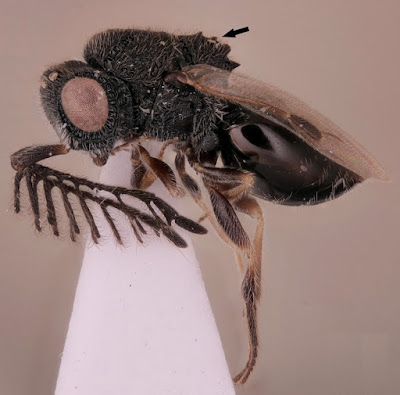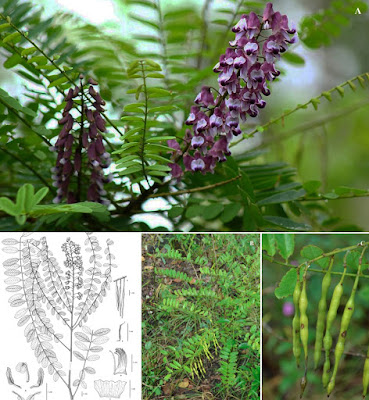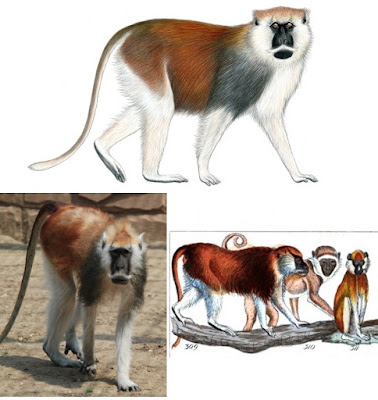[Most Recent Entries] [Calendar View]
Saturday, February 3rd, 2018
| Time | Event | ||||||
| 8:57a | [Entomology • 2018] Dendrocerus scutellaris • Unique Extrication Structure in A New Megaspilid (Hymenoptera: Megaspilidae) from Costa Rica
Abstract Background A new species, Dendrocerus scutellaris Trietsch & Mikó (Hymenoptera: Megaspilidae), is described here from male and female specimens captured in Costa Rica. This species is the only known ceraphronoid wasp with a straight mandibular surface and raised dorsal projections on the scutellum, called the mesoscutellar comb. It is hypothesised that the function of the mesoscutellar comb is to aid the emergence of the adult from the host, especially since the mandibles lack a pointed surface to tear open the pupal case. The authors also provide phenotypic data in a semantic form to facilitate data integration and accessibility across taxa and provide an updated phenotype bank of morphological characters for megaspilid taxonomic treatments. In updating this phenotype bank, the authors continue to make taxonomic data accessible to future systematic efforts focusing on Ceraphronoidea. New information A new species, Dendrocerus scutellaris (Hymenoptera: Megaspilidae) Trietsch & Mikó, is described from both male and female specimens captured in Costa Rica. Keywords: Ceraphronoidea, morphology, systematics, taxonomy, eclosion Dendrocerus scutellaris Trietsch & Mikó, sp. n. Diagnosis: Dendrocerus scutellaris belongs to the Dendrocerus halidayi species group (Dessart 1995, Dessart 1999), based on the branched male flagellomeres, bifid anteromedian projection of the metanoto-propodeo-metapectal complex and the presence of parossiculal projections with 3 parossiculal setae. This species is distinguished from all other ceraphronoid species by the presence of the mesoscutellar comb, an anatomical cluster that is composed of a row of spines medially on the mesoscutellar-axillar complex. This species is also unique amongst Ceraphronoidea in that the distal edge of mandible is flat and not pointed. Etymology: This species is named for the presence of the mesoscutellar comb, which is unique to this species and is not found in any other known ceraphronoid species. Distribution: This species is only known from Costa Rica. Carolyn Trietsch, István Mikó, David G. Notton and Andrew R. Deans. 2018. Unique Extrication Structure in A New Megaspilid, Dendrocerus scutellaris Trietsch & Mikó (Hymenoptera: Megaspilidae). Biodiversity Data Journal. 6: e22676 DOI: 10.3897/BDJ.6.e22676 New parasitoid wasp likely uses unique saw-like spines to break out of i... http://bit.ly/2rVmEAN via @Pensoft @EurekAlert | ||||||
| 9:02a | [Mammalogy • 2018] Tylonycteris malayana eremtaga • A New Subspecies of the Malayan Bamboo Bat (Chiroptera: Vespertilionidae) from the Andaman Islands, India
Abstract The bamboo bats belonging to the genus Tylonycteris are unique due to their morphology and ecology, and are known from few locations in South Asia. We collected voucher specimens of Tylonycteris malayana from North Andaman Island, which forms the basis of the first specimen-based record of this species from the Andaman & Nicobar Islands, and the second record from India. Our analyses based on morphometrics, craniodental measurements, bacular morphology and molecular phylogeny based on cytochrome c oxidase subunit I gene indicate that the insular population of T. malayana may have diversified in isolation to differ from the mainland forms, and could represent putative new subspecies, described herein. In light of the new findings, we discuss the importance of conducting detailed study on the specimens of the Lesser Bamboo Bat earlier reported from the Andaman & Nicobar Islands to ascertain their taxonomic status. Keywords: Bamboo Bat, cryptic diversity, molecular phylogeny, North Andaman Island, Tylonycteris pachypus. Tylonycteris malayana eremtaga ssp. nov. Andaman Bamboo Bat Holotype: NHMOU.CHI.151.2015, adult male, 06.xi.2015, near Bamboo Tekri, Chipo Village, Diglipur, North Andaman Island, Andaman & Nicobar Islands, India; coll. A. Gopi & Tauseef Hamid Dar. Diagnosis: A small bat with a forearm length up to 23.3–26.25 mm. Dorsal pelage uniformly grey-brown, venter slightly paler; wings and interfemoral membrane dark brown. Although the new subspecies is essentially similar to nominotypic T. m. malayana (see Tu et al. 2017), it varies from the nominate form slightly in having smaller craniodental features (GTL: 11.5 in T. m. eremtaga ssp. nov. vs 11.73–12.90 in T. m. malayana). The rostrum is robust in T. m. eremtaga ssp. nov., shorter and broader than that of the nominate subspecies (CM3: 3.7–4.1 in T. m. eremtaga ssp. nov. vs 3.74–4.31 in T. m. malayana; RW: 5.7–6.1 in T. m. eremtaga ssp. nov. vs 5.3–5.6 in T. robustula sensu lato (see Bates & Harrison 1997). Externally, the fur color of T. m. eremtaga ssp. nov. appears to be uniform grey-brown while that of T. m. malayana is dark brown. Description: A small bat with a forearm length up to 26.25mm. Head characteristically flat, projecting forwards and downwards (Image 1a). Ears roughly triangular with broadly rounded tips. Tragus short and broad. Base of the thumb and the soles of the feet have broad fleshy pads (Image 1b). Wings short with 3rd, 4th and 5th metacarpals roughly equal in length. Wing and interfemoral membranes dark brown (Image 1a,b), pelage fine and dense, uniformly grey-brown on the dorsum, slightly paler on the ventral surface. .... Etymology: The subspecific epithet, ‘eremtaga,’ is a Latinized noun derived from the Aka-Kora dialect of the Great Andamanese language, meaning ‘forest-dweller’. Ecological notes: The presence of multiple males in the area suggests the existence of a colony of these bats in the near vicinity of the village. The specimens collected from Chipo Village, Diglipur, North Andaman Island were found to share their habitat with other species such as the Greater Short-nosed Fruit Bat Cynopterus sphinx, the Lesser Short-nosed Fruit Bat Cynopterus brachyotis, Tickell’s Bat Hesperoptenus tickellii, and the Andaman Intermediate Horseshoe Bat Rhinolophus affinis andamanensis. This subspecies is currently known only from Chipo Village, Diglipur, North Andaman Island, Andaman & Nicobar Islands, India. Chelmala Srinivasulu, Aditya Srinivasulu, Bhargavi Srinivasulu and Gareth Jones. 2018. A New Subspecies of the Malayan Bamboo Bat (Chiroptera: Vespertilionidae: Tylonycteris malayana eremtaga) from the Andaman Islands, India. Journal of Threatened Taxa. 10(1); 11210–11217. DOI: 10.11609/jott.3906.10.1.11210-11217 | ||||||
| 9:02a | [Botany • 2018] Sophora huamotensis • A New Species of Sophora (Fabaceae-Papilionoideae-Sophoreae) from Thailand
ABSTRACT Sophora huamotensis Mattapha, Suddee & Rueangr. is illustrated and described here. This new species is recognised by having numerous leaflets, articulated pedicels and the wing petals with lunate sculpturing on the outer surface and without auricles at the base. The morphological characters of the species are compared and discussed with its closest species. Description, illustration, images and a distribution map of the new species are provided. KEYWORDS: Doi Hua Mot, endemic, Leguminosae, Tak, Umphang district
Sophora huamotensis Mattapha, Suddee & Rueangr., sp. nov. The species is closely similar to S. rubrifloraTsoong from which it differs markedly in the shape of leaflets (oblong-elliptic to ovoid-obovate in S. huamotensis vs oblong-oval in S. rubriflora), more numerous leaflets (23–39 in S. huamotensis vs 19–21 in S. rubriflora) and wing petals not auriculate (with distinctly 2-sided auriculate in S. rubriflora). .... Ecology.— Dry deciduous dipterocarp forest on degraded limestone mountains, dominated by Shorea obtusa Wall. ex Blume, S. siamensis Miq., Quercus helferiana DC., Buxus sirindhorniana W.K.Soh, von Sternb., Hodk. & J.Parn. and Phoenix loureiroi Kunth; 760–780 m elevation. Etymology.— The specific epithet refers to the name of the mountain “Doi Hua Mot”. Vernacular name.— Phit sanat doi hua mot (พิษนาศน์ดอยหัวหมด), the name is given by the authors. Sawai Mattapha, Somran Suddee and Sukid Rueangruea. 2018. Sophora huamotensis, A New Species of Sophora (Fabaceae-Papilionoideae-Sophoreae) from Thailand. THAI FOREST BULL., BOT. 46(1): 4–9. DOI: 10.20531/tfb.2018.46.1.02 | ||||||
| 9:09a | [Mammalogy • 2017] On the Taxonomy of Erythrocebus with A Re-evaluation of Erythrocebus poliophaeus (Reichenbach, 1862) from the Blue Nile Region of Sudan and Ethiopia
Abstract Erythrocebus taxonomy has been dormant for almost a century now, with the consequent costs in our understanding of the biology of the genus and for the conservation of these remarkable monkeys. New data on the distribution and physical appearance of patas monkeys in Ethiopia, together with a review of the old taxonomic literature, allows to us disentangle some questions concerning the taxonomy of Erythrocebus in northeast Africa. Specifically, I resurrect Erythrocebus poliophaeus (Reichenbach, 1862) as a valid species that is found along the Blue Nile Valley at the extreme northeastern portion of the range of the genus. The still little-known, but certainly limited, extent of the range of the species is a cause for conservation concern, but it may be that Erythrocebus poliophaeus could serve as a flagship species for conservation in the biologically rich Western Ethiopian Escarpment region and adjoining Sudan. The proposed common English names for the new species are Heuglin’s patas monkey (Heuglin was the famous German explorer who discovered it) or the Blue Nile patas monkey. Keywords: Benshangul Gumuz State, Ethiopia, Sudan, Primates, Cercopithecidae, patas monkey, taxonomy
Erythrocebus poliophaeus (Reichenbach, 1862) Heuglin’s or Blue Nile patas monkey Syn. Cercopithecus poliophaeus Reichenbach, 1862 Cercopithecus poliolophus Heuglin, 1877, renaming of poliophaeus Erythrocebus albigenus Elliot, 1909 .... Conclusions: As anticipated by Allen (1925), some of the named forms of Erythrocebus could be valid taxa if more evidence came to light. The main aim of the article was to revive interest in the topic and highlight some conservation priorities in East Africa. A species first described over 150 years ago is re-evaluated; it is known from the Blue Nile basin in western Ethiopia and adjoining Sudan, and separated from another Erythrocebus taxon by the Sudd swampy region in Sudan and the Ethiopian highlands, which stretch up to the Sudanese border north of Gambela. It is an obvious focus for further research and conservation. Monkeys of the genus Erythrocebus are potential flagships for important African ecosystems, and may well be at greater risk than is generally believed. The western Ethiopian escarpment flora has received due scientific attention only in this century, and a number of new endemic species have been discovered in Benshangul Gumuz in recent years (Sebsebe Demissew et al. 2005). A revised taxonomy of the genus Erythrocebus is also fundamental to analyze the available data concerning the natural history and biology of the different taxa. With the recognition of the Heuglin or Blue Nile patas monkeys Erythrocebus poliophaeus we have now two taxa with a black face and nose (at least in the adult male)—the other being Erythrocebus baumstarki— at the fringe of the genus’s range in East Africa, and possibly representing ancient surviving lineages that have been supplanted by a white-nosed species elsewhere in East Africa that is provisionally referred as Erythrocebus pyrrhonotus, with E. p. formosus and a number of other subspecies occurring over its range Spartaco Gippoliti. 2017. On the Taxonomy of Erythrocebus with a Re-evaluation of Erythrocebus poliophaeus (Reichenbach, 1862) from the Blue Nile Region of Sudan and Ethiopia. Primate Conservation. 31; 53-59. BBC News - Moustached monkey is separate species bbc.com/news/science-environment-4272055 |
| << Previous Day |
2018/02/03 [Calendar] |
Next Day >> |














